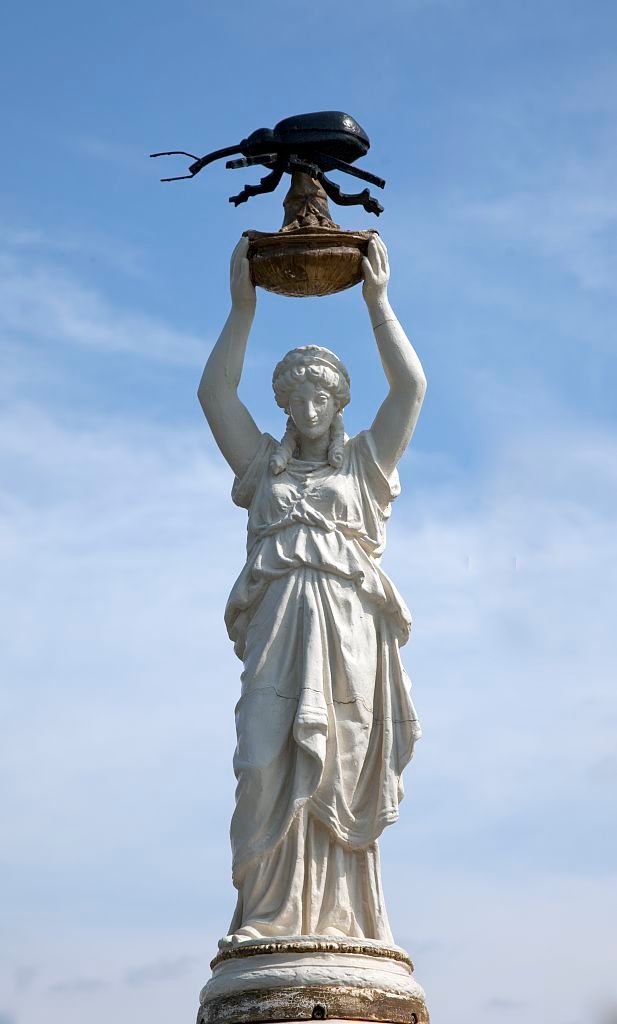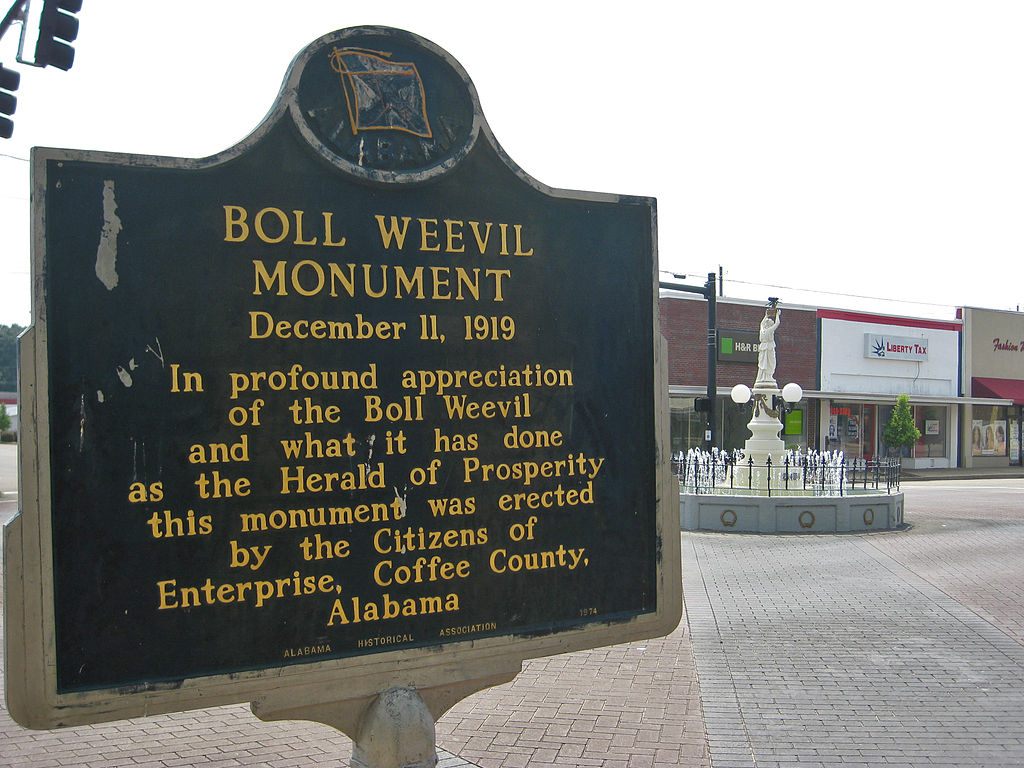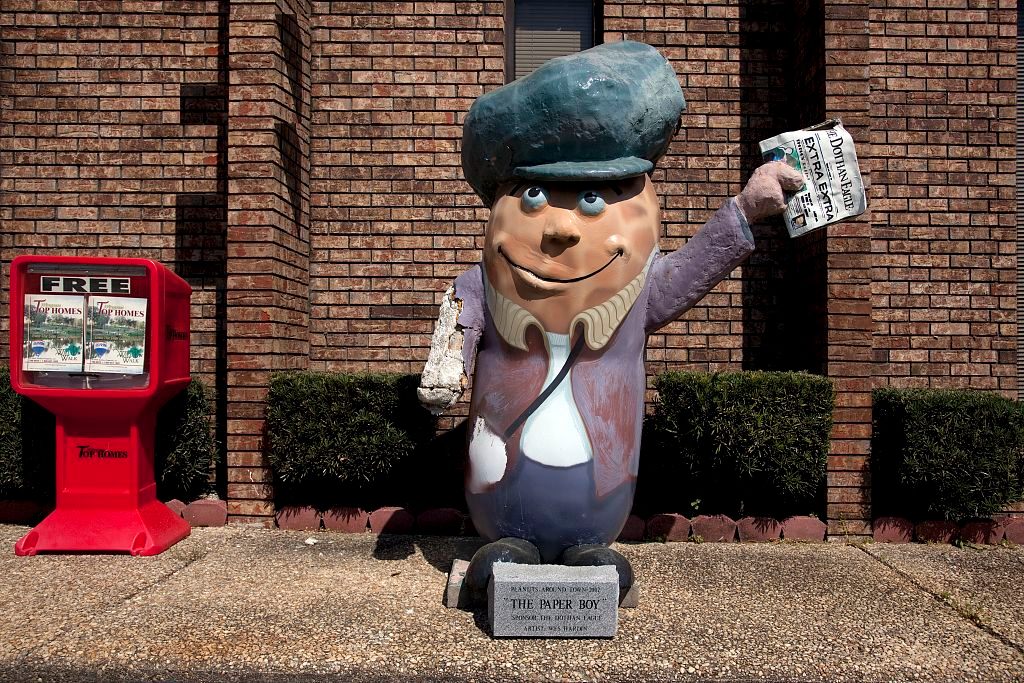The World’s Only Monument To A Horrible Destructive Pest Is In Alabama

The Boll Weevil Monument in Enterprise, Alabama (Photo: Library of Congress)
In Enterprise, Alabama, there is a statue unlike any other in the entire world: A 13-foot woman in Grecian-style robes holding up … a giant bug. The Boll Weevil Monument reigns as the only monument to an agricultural pest on Earth, for obvious reasons. Why would anyone want to honor a blight? Especially one that destroyed thousands of farms throughout the Americas?
 The Alabama Historical Association marker for the Boll Weevil Monument, with the Monument in the background to the right. (Photo: TampAGS/WikiCommons CC BY-SA 3.0)
The Alabama Historical Association marker for the Boll Weevil Monument, with the Monument in the background to the right. (Photo: TampAGS/WikiCommons CC BY-SA 3.0)
But there’s no irony to the Boll Weevil Monument, since the town is legitimately grateful to the ferocious little bug.
The boll weevil, a very small variety of beetle, is native to Mexico, and nests in the boll–or seed capsule–of cotton, hence its name. With its distinctive long snout, the boll weevil is a legendary pest, one of the all-time greats on the list of most feared insects of the agricultural world. It moves where the cotton grows, and migrated across the Rio Grande from Mexico into Texas as soon as the land there had decent cotton fields for it to feed on, in 1892. It moves quickly; the beetle is a decent long-distance flier, and individual beetles have been found as far as 150 miles away from where they were tagged. By 1909, the boll weevil had landed in Alabama.

A boll weevil up close (Photo: Leong9655/shutterstock.com)
By 1915, the incorrigible weevil had made its way all the way to Enterprise, a small city near the state’s southern border. In Coffee County, where Enterprise sits, almost 60% of the cotton crop was destroyed that year. The weevil is extremely difficult to expel; farmers tried spraying with absurd amounts of pesticides, but the weevil quickly developed an immunity to the poison. Within a few years, farmers were losing entire crops to the weevils. Nothing was working. In fact, coupled with the Great Depression just over a decade later, the boll weevil very nearly destroyed the entire South.

An illustration from a 1910 Farmer’s Bulletin, produced by the United States Department of Agriculture. Part of the USDA’s education program was an effort to raise farmers’ awareness and knowledge of the boll weevil and how it could harm their crops (Photo: Public Domain/WikiCommons)
But not in Enterprise. Other areas that relied on cotton attempted to fight the boll weevil with hardly any success until the early 1980s, when a federal program to eradicate them began to make some headway. (Today they use pheromone traps, which mostly work.) Yet Enterprise, and the rest of Coffee County, decided to hell with cotton!
Cotton is full of weevils. Know what’s not full of weevils? Peanuts.
Alabama has a perfect climate for growing peanuts–Dothan, a town not far from Enterprise, claims the title of “Peanut Capital of the World.” And the early 1900s were a fine time to begin growing the beloved legume: peanuts were mostly ignored in the U.S. until the late 1800s, when P.T. Barnum began selling them at the circus. At the turn of the century, an array of new machines for planting, harvesting, and shelling peanuts were invented, and in 1915, George Washington Carver began his crusade on behalf of the crop. Enterprise began growing peanuts just after the weevils arrived, and by 1917, Coffee County was the leading producer of peanuts in the entire country.
 The nearby town of Dothan, Alabama, named the ‘Peanut Capital of the World’, has various forms of peanuts depicted all around town. (Photo: Library of Congress)
The nearby town of Dothan, Alabama, named the ‘Peanut Capital of the World’, has various forms of peanuts depicted all around town. (Photo: Library of Congress)
The switch from cotton to peanuts is credited not just with saving the town from destruction by weevils, but also for introducing a level of prosperity that was new to in Enterprise. On December 11, 1919, the town unveiled a beautiful, earnest statue in honor of the boll weevil, for forcing the town to abandon one crop and adopt a far better one. Initially, the statue was just a Grecian-looking woman raising her hands above her head, but 30 years later, in 1949, a boll weevil was added on a pedestal atop her hands.
For some reasons, the statue was the victim of frequent vandalism; it was damaged beyond repair in 1998. A replica was made and stands in its place, while the original stands in the Pea River Historical & Genealogical Society, a museum dedicated to preserving the history of Enterprise.
Update, 5/29: An earlier version of the story incorrectly noted the nearest state to Enterprise, Alabama. It’s Florida, not Louisiana. We regret the error.




Follow us on Twitter to get the latest on the world's hidden wonders.
Like us on Facebook to get the latest on the world's hidden wonders.
Follow us on Twitter Like us on Facebook